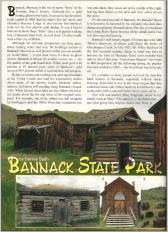Bannack State Park
Bannack, Montana is the site of many “firsts” in the Treasure State’s history. Although it’s a gold mining ghost town today, it served as the first territorial capital in 1864, had the state’s first jail, hotel, and chartered Masonic Lodge. It also had the first hard rock mine and the first electric gold dredge. If you’d like to learn more about these “firsts” take a self-guided walking tour of Bannack State Park, located about 25 miles southwest of the city of Dillon. Although the old-time prospectors are long gone, many mining relics and over 60 buildings remain. Most are so well preserved that you can actually go inside them— a rare treat when it comes to ghost gowns. Bannack is unique for another reason, too— for the quality of the gold found here. While most gold is 80% to 95% pure, some of Bannack’s gold assayed 99.5%, which is equivalent to refined gold.
Before you start your walking tour, pick up a brochure at the Visitor Center and read the entertaining stories about many of the homes, hotels, bachelor cabins, saloons, and stores still standing along Bannack’s boardwalk. While factual, these tales are also filled with colorful details about the life and times of the original occupants. For example, one of the cabins was still occupied by bootleggers until the 1960s. When they learned the law was onto them, they snuck out in the middle of the night, leaving their dishes on the table and their coffee pot on the stove. On the southeast end of Bannack, the Bessette House is believed to be haunted by the children who died here during an epidemic of scarlet fever. The site is nicknamed the Crying Baby House because of the sounds some visitors have reported hearing.
Bannack’s rich history began 150 years ago with John White’s discovery of placer gold along the banks of Grasshopper Creek. In July 1862, Mr. White filed one of the first recorded mining claims in what was later to become the state of Montana. Good news traveled fast and by fall of that year, “Grasshoper Diggins” was home to 400 prospectors. By the following spring, the population had swelled to 3,000 — the Gold Rush was definitely on! It’s a wonder so many people survived the first few hard winters in Bannack, especially without sturdy housing. Some had to live in the same wagon that they rolled into town with. Others had time to build only a one-room cabin with a sod roof before heavy snow set in. One wife and mother, Mary Edgerton, wrote to her family back in Ohio, “The mercury in the thermometers after going forty degrees below zero froze in the bulb. I was so afraid that the children would freeze their noses or ears that I got up a number of times in the night to see that their heads were covered. Their beds would be covered with frost.” Despite temperature extremes that sites at an elevation of 5,780 feet can experience year round, the pioneer miners proved to be made of hardy stock and persevered.
In late 1863, the rough and tumble mining camp officially became the town of Bannack, named for the Bannock Indians who frequented the area. (Bannock is actually a Scotch word meaning “a cake cooked over an open fire.” Camas root cakes were a staple for the Native Americans). Notice the slight difference in spellings between Bannock and Bannack. Washington D.C. made a mistake on the town’s official paperwork, turning the “o” into an “a” and creating the name Bannack. The first placer deposits found in Grasshopper Creek were easy to work and required only gold pans, sluice boxes, and rocker boxes. Although gold was worth only $18 an ounce back then, one happy miner, Robert Kirkpatrick, commented in his journal in 1863: “…Often one to fifteen dollars to the pan was got in a few choice spots and I have seen the best dirt on the bedrock yellow with gold as it was shoveled up… some went from fifteen to seventy-five dollars to the pan.” Can you imagine what Mr. Kirkpatrick would think if he was working his same claim now, but reaping the reward of today’s gold prices?! This article appeared in the March/April 2012 issue of Gold Prospector Magazine. Click the image below download the full article as a .pdf. |
|
|


